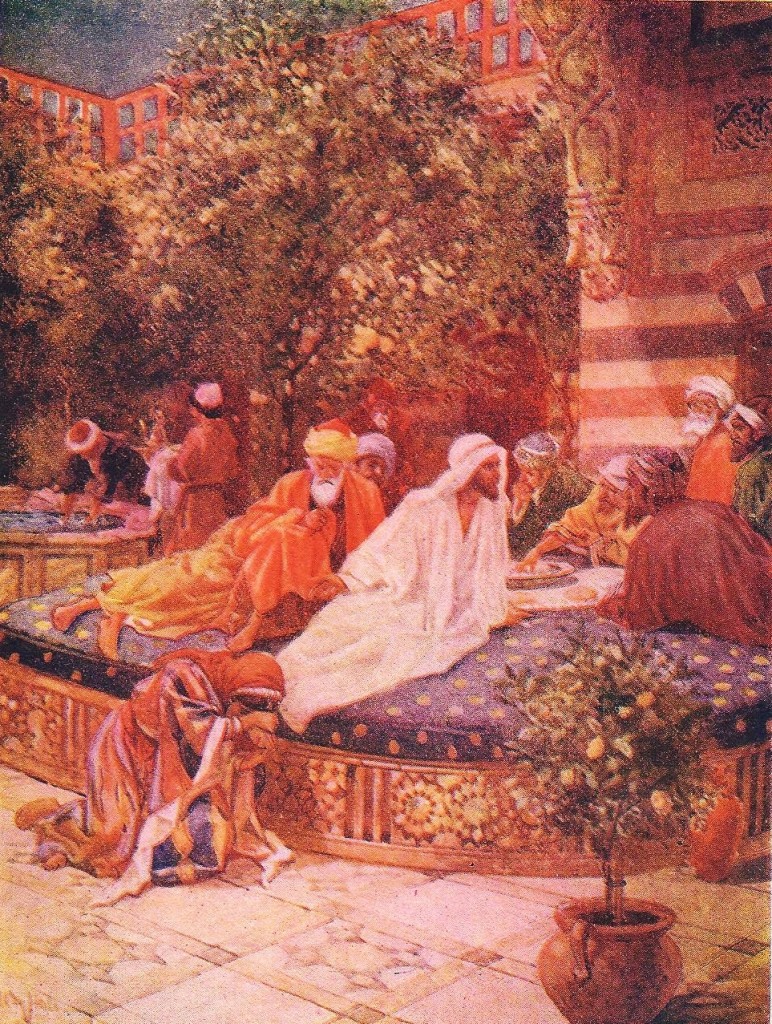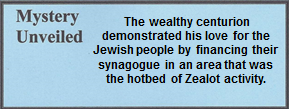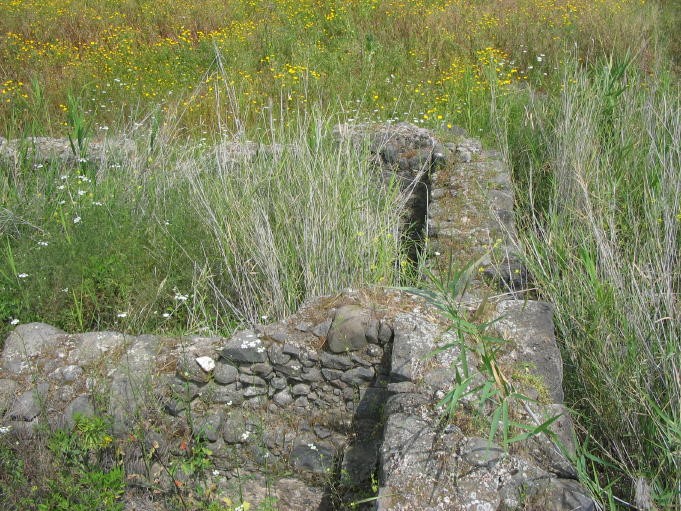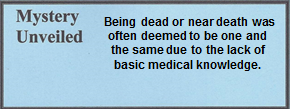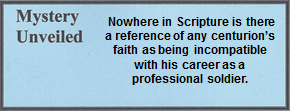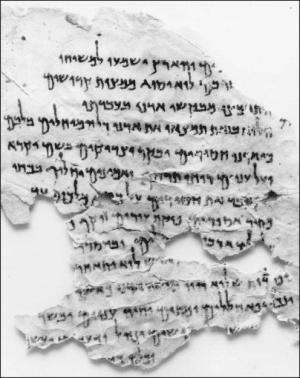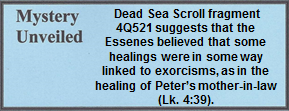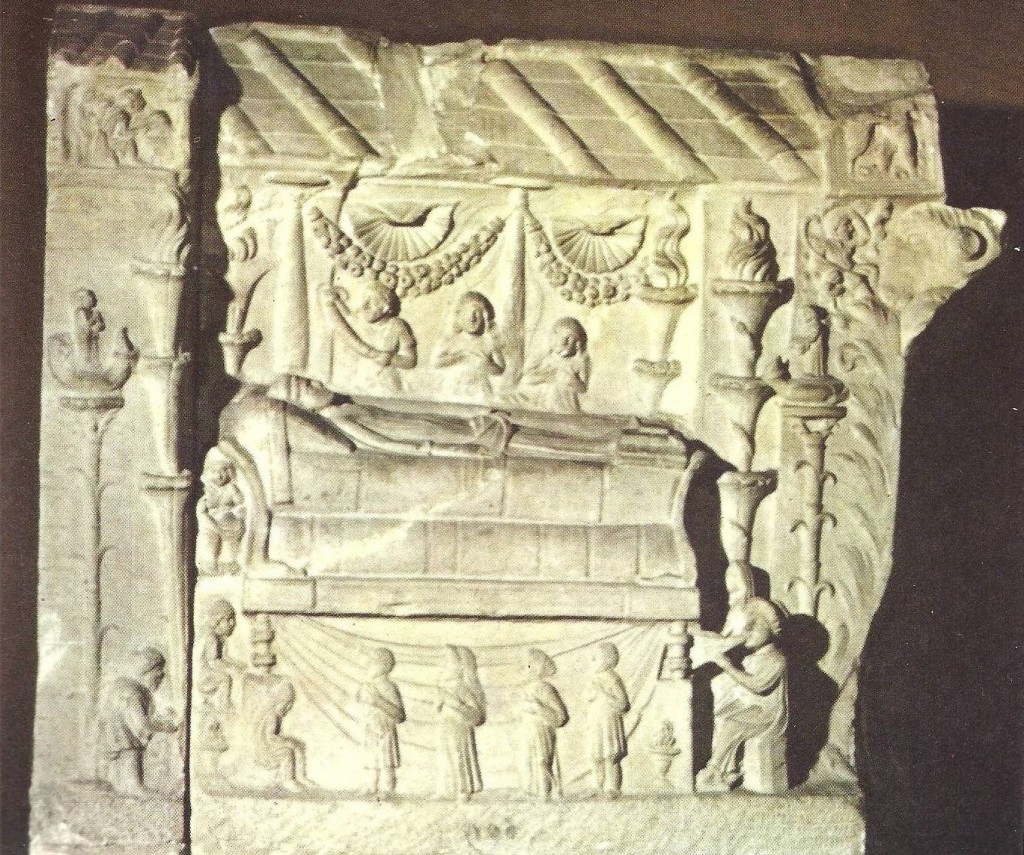08.05.07 Lk. 7:36-50
ANOINTING BY A SINFUL WOMAN
36 Then one of the Pharisees invited Him to eat with him. He entered the Pharisee’s house and reclined at the table. 37 And a woman in the town who was a sinner found out that Jesus was reclining at the table in the Pharisee’s house. She brought an alabaster jar of fragrant oil 38 and stood behind Him at His feet, weeping, and began to wash His feet with her tears. She wiped His feet with the hair of her head, kissing them and anointing them with the fragrant oil.
39 When the Pharisee who had invited Him saw this, he said to himself, “This man, if He were a prophet, would know who and what kind of woman this is who is touching Him — she’s a sinner!”
40 Jesus replied to him, “Simon, I have something to say to you.”
“Teacher,” he said, “say it.”
41 “A creditor had two debtors. One owed 500 denarii, and the other 50. 42 Since they could not pay it back, he graciously forgave them both. So, which of them will love him more?”
43 Simon answered, “I suppose the one he forgave more.”
“You have judged correctly,” He told him. 44 Turning to the woman, He said to Simon, “Do you see this woman? I entered your house; you gave Me no water for My feet, but she, with her tears, has washed My feet and wiped them with her hair. 45 You gave Me no kiss, but she hasn’t stopped kissing My feet since I came in. 46 You didn’t anoint My head with olive oil, but she has anointed My feet with fragrant oil. 47 Therefore I tell you, her many sins have been forgiven; that’s why she loved much. But the one who is forgiven little, loves little.” 48 Then He said to her, “Your sins are forgiven.”
49 Those who were at the table with Him began to say among themselves, “Who is this man who even forgives sins?”
50 And He said to the woman, “Your faith has saved you. Go in peace.”
“He entered the Pharisee’s house and reclined at the table.” When Jesus entered the home of the Pharisee, He reclined on cushions at a table to eat with His host. When people “reclined,” they did so around a “U” shaped table known as a triclinium. It was the same type of table Jesus and the disciples reclined at during their Last Passover Supper. In earlier times, people sat on floor mats with legs crossed to eat meals. The custom of reclining on cushions appears to have been adapted by the Jews as early as the days of Amos. (See 6:4, 7). The custom was long in use among the Persians, Greeks and Romans. However, it also appears that, among the poor Jewish peasant farmers, sitting on mats at mealtime continued to be a first century custom.
“A woman in the town who was a sinner.” The phrase “sinner,” when applied to a woman, could have three possible meanings.
- Any person who broke the moral laws of the written Scriptures. Quite often the word sinners was a euphemism for prostitutes. In fact, prostitution was the only kind of “occupation” she could have had that would have given her that social stigma.[1]
- The term was applied to women who had their hair uncovered in public.[2]
- It should be noted, however, that the Pharisees defined a sinner as anyone who did not conform any one of their legalistic rituals – the Oral Laws – which included numerous prayers and washings throughout the day. For example, the ultra-strict Pharisees even considered anyone who touched a Roman or Greek coin as filthy because he violated the command against graven images.[3] These coins had graven images of an emperor and/or a pagan deity.
The earliest tradition identifies her to have been Mary Magdalene from the village of Magdala, located along the western shore of the Sea of Galilee. Amazingly, the self-righteous Pharisee, who made certain that no one would ever see him with an impure person did not objected to having a “sinner” in his house. Rather, he focused on Jesus. Scholars have considered two possible reasons she may have been there.
- She may have been invited, not by Jesus, but by the Pharisee so he could condemn Jesus; in essence, she was a set-up. But, such a person would probably not have been so emotionally affected by His presence.
- She walked in uninvited, honored Jesus and worshiped Him as her Lord.
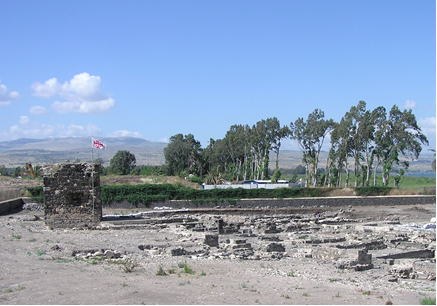
08.05.07.A. THE RUINS OF MAGDALA. The village and watch tower ruins (left side with flag), south of Capernaum, as seen in 2010, has been suspected to be Magdala, the village home of Mary Magdalene (meaning Mary from Magdala). Photograph by the author.
The Hebrew name for Magdala is Migdol, meaning tower, and the lower portion of an ancient tower still stands from where watchmen once were stationed, looking for those who might steal fish and nets. To the founders of the ancient village, the name Magdala, or Migdal-El, meant the Tower of God.[4] As to the village of Magdala, it was an important commercial fishing center where fish was salted and sold to traveling caravans. It is believed to have had the Aramaic nickname of Dalmanutha, which means the harbor. Today a few scholars believe that the village may also have been the home of a first century synagogue-church, but that opinion is based more on speculation than solid archaeological or literary evidence. However, that might change in the future.
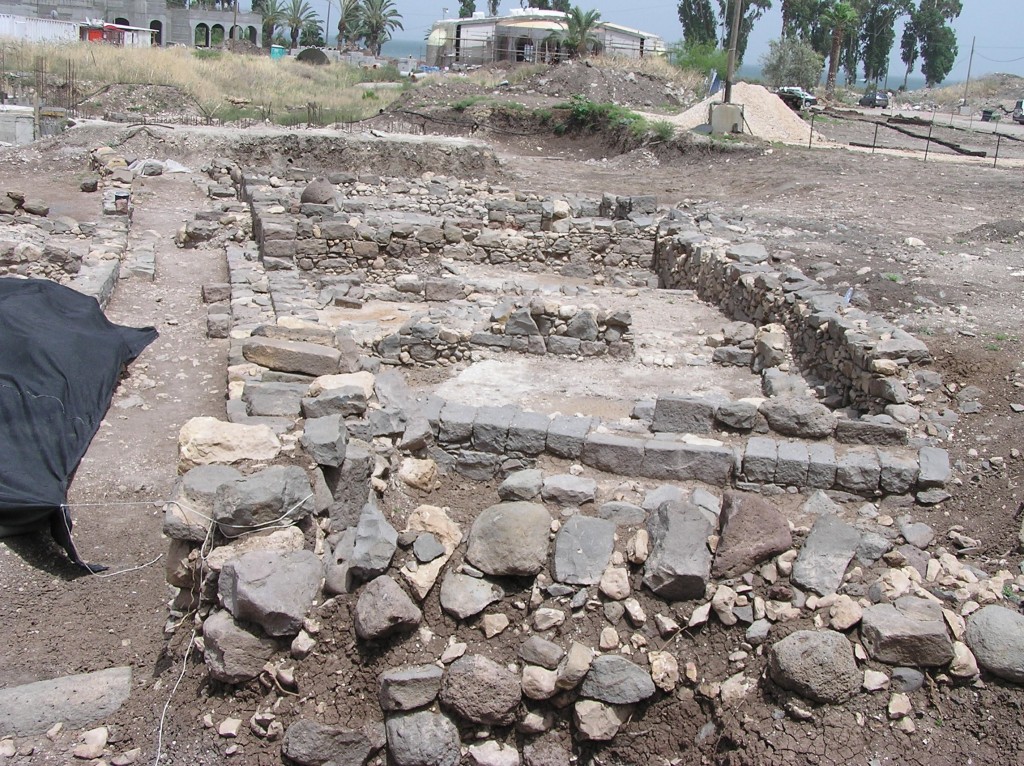
08.05.07.B. THE RUINS OF MAGDALA FISH MARKET. Archaeologists uncovered three buildings that had masonry tubs which functioned as aquariums. Customers could purchase live fish for dinner or salted fish for traveling caravans. Photograph by the author.
In 2009 archaeologists unearthed a synagogue that is amazing well-preserved, and substantially more ornate than many of the other synagogues from the first century found in the area. They noted that the synagogue was located on the outskirts of what were then the city limits of Migdal (known in the New Testament as Magdala), rather than in the center of the city as in other communities. Its small size would accommodate only about 120 people, but the population of Magdala at the time was several thousand. All this likely means that the synagogue belonged to a small “outsider” sect that placed great value in its spiritual community life.[5]
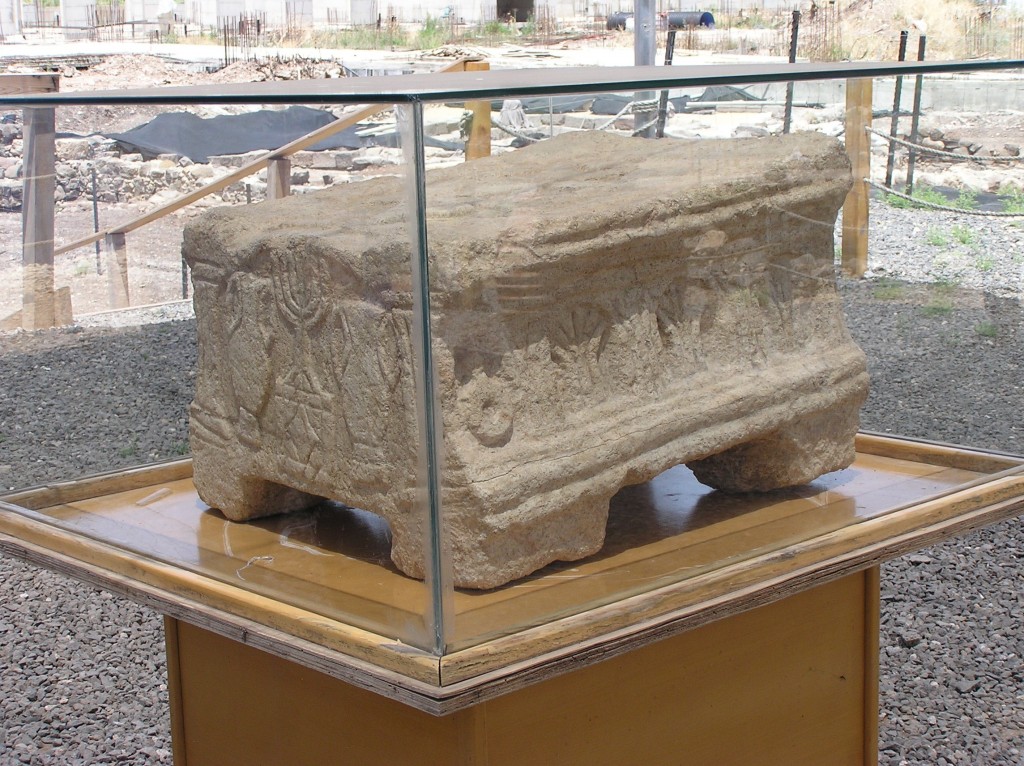
08.05.07.D. FIRST CENTURY MAGDALA SYNAGOGUE STONE. In 2009 archaeologists uncovered a small ornate stone in the ruins of a small synagogue near the edge of Magdala. The unusual stone has carvings reflective of the temple design but its purpose remains unknown. It is also a mystery as to why the synagogue was built for less than a hundred people when several thousand lived in the community. Some have suggested the facility may have served an “outside group,” such as a messianic congregation, since groups of believers were too large for home churches but too small for regular synagogue building. Photo by the author.
The Pharisees sent their spies out to see if they could entrap Jesus. Rarely did a Pharisee invite Jesus to his home, but when such an invitation was given, Jesus accepted. It was at the banquet table,[6] where the guests reclined around a low Greco-Roman table to eat. Then a woman of “low reputation” appeared in this pious household and met with Jesus. An early tradition of the church identified her as being Mary Magdalene.
“Alabaster jar of fragrant oil.” Alabaster, a/k/a Egyptian alabaster, or Oriental alabaster.[7] Alabaster jars and vessels were manufactured in Egypt, often shipped by boat across the sea to India and, by caravan shipped to the Indus River Valley and mountains in northern India, Nepal and the Himalaya Mountains.[8] It was there that spikenard perfume was made from rare plants, placed in alabaster vessels, and returned to the western Indian coast to be shipped throughout the world. Because it was one of the costliest perfumes, it was often passed from generation to generation. The woman in this passage brought her most precious and expensive possession, Indian spikenard, and anointed Jesus with it.[9] It was the best she could offer him. Visitors and tourists who purchase “Spike perfume” in Israel today do not purchase the authentic perfume, but a synthetic imitation.
The fact that she anointed the feet of Jesus with it speaks volumes of her love. As stated previously, throughout the Middle East, in ancient times and today, feet are considered defiled.[10] Throughout most of history, wherever anyone walked, livestock did likewise and, therefore, stepping into animal dung was unavoidable. Sandals and shoes were, and still are, removed when entering a home and feet are washed. Only the lowest of servants or slaves untied sandals for visitors, and if there were no servants or slaves, then it was the woman’s responsibility to do so. The anointing of fragrant oil was more than the cultural washing of the feet – it was the most she could do.
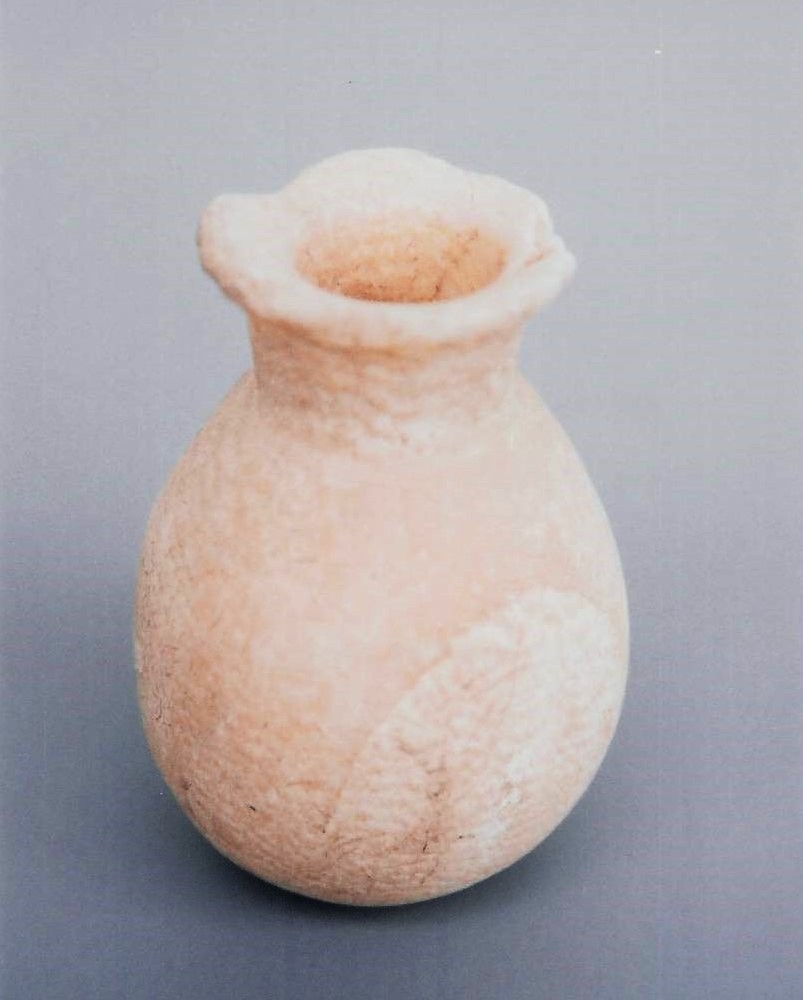
08.05.07.C. A FIRST CENTURY ALABASTER BOTTLE. Alabaster is stone that was mined and sculptured in Egypt, then shipped to India where the vessel was filled with perfume, and then shipped throughout the known world, including Israel. Artifact and photograph by the author.
“Kissing them.” Hospitality was a sacred duty in the Middle East. Whenever a traveler entered a village, it was not his responsibility to find a place to stay, but it was the duty of the villagers to invite him for the night. The kindest and most gracious gift of hospitality of the biblical period was a social dynamic that is difficult for Westerners today to comprehend. Therefore, when Jesus arrived at the house of the Pharisee, the host did not extend the three customary signs of hospitality to Jesus.
- No water was given for His feet.
- Jesus was not greeted with the customary kiss.
- No oil was placed upon His head.
The Oral Law so strongly condemned these acts of hospitality violations that it said if one committed any one of these acts, he would be condemned to hell.[11] Then came the “sinful woman,” who honored Jesus. Her actions were as follows:
- She shed her tears on His feet, kissed them, and
- She poured her expensive perfume instead of oil on Him.
- It would have been inappropriate for her to kiss Him, and she didn’t.
The Pharisee had not demonstrated any religious or cultural courtesies, yet this woman, who previously had broken every religious and cultural rule, displayed repentance and courtesies. Clearly, in this moving scene there was a great polarization between the repentant woman and the insulting Pharisee. Jesus, however, forgave her of past sins and remained calm with His insulter.[12] Jesus is not a respecter of persons, but a respecter of attitudes and motives.
Men’s opinions of women were not always very good. For example, Josephus and Nicholaus of Damascus seldom mention then names of women.[13] On the positive side, the book of Proverbs has the well-known description of a wife of noble character (31:10-31). In a book of the Apocrypha, the position of a good wife is honored. Notice the Hebraic poetry:
Happy is the husband of a good wife,
the number of his days will be doubled.
A loyal wife rejoices her husband,
and he will complete his years in peace.
A good wife is a great blessing,
she will be granted among the blessings of the man who fears the Lord
Whether rich or poor, his heart will be glad,
and at all times his face is cheerful.
Ben Sirach 26:1-4[14]
On the negative side, there are several writings concerning the evilness of womanhood. These refer to women in general, not to sinful women such as the one Jesus encountered. Josephus refused to admit the testimony of a woman, because of the boldness of her sex.[15] In the Oral Law, women were at times considered to have the same status as slaves and minors.[16] Their curiosity was considered evil and, therefore, unclean.[17] Several other writings are equally negative as a general attitude. Note the following from the Oral Law:
He that talks much with womankind brings evil upon himself and neglects the study of the Law and at last will inherit Gehenna.
Mishnah, Aboth 1.5
With the religious community and the common people rejecting her, she could easily have totally given up on any kind of reconciliation with God. But then came Jesus!
“If He were a prophet.” The Pharisees were so angry that they failed to think logically. They questioned if Jesus was really a prophet, and failed to realize that as a prophet, He could read their thoughts.
“You have judged correctly.” This was one of the highest compliments any rabbi could receive. It was always a challenge to correctly apply Scripture to the daily events of life.
“Washed My feet and wiped them with her hair.” This phrase, and the differences in the parallel accounts, has always given Bible students difficulty. In Luke 7:38 and John 12:3 she washed or anointed His feet, but according to Mark 14:3 and Matthew 26: 7 she poured it on his head, Luke and John indicate that she wiped His feet with her hair, but Mark and Matthew do not mention this. Furthermore, there is a Mary, who may not be the same woman as in this narrative, in John 11:2 who also anointed the feet of Jesus. This difference cannot be explained. As is so often the case, what can easily be perceived as an error is clarified when additional details are presented. This has been the case repeatedly with other biblical difficulties. Therefore, whenever additional information is available, these passages will be clarified.
The fact that this woman took her head covering off and wiped the feet of Jesus with her hair is absolutely stunning. It was against all cultural courtesies, which reflects her passionate love of Jesus. To properly understand the cultural context behind her action, a brief study of a woman’s hair and her head covering is warranted.
Pious women always had their hair covered in the ancient Middle East. That cultural tradition was significant in many other cultures as well. In the Jewish communities it was for both physical protection from the sun as well as symbolic that she was under the protection of her husband, brother, or father.[18] Even today in conservative Muslim communities, women have their heads covered – a tradition that dates back to the Old Testament Period. Those women who did not cover their heads in public were often deemed to be prostitutes or “temple virgins” in pagan temples (a/k/a “clerical prostitutes”). However, in some Greco-Roman cities the cultural taboo was dropped. This may be why the Apostle Paul, who wrote to the church in the very sexually promiscuous city of Corinth, that a woman should have her head covered (1 Cor. 11:5-6).[19]
In the Jewish community, a virgin had her hair covered and her soon-to-be husband did not see her hair until their wedding night. Some did not even have their heads uncovered at home. For a Jewish woman to go out in public with her hair uncovered was a reason for divorce.[20] According to the Mishnah divorce was possible if she went out,
With her hair unbound, or spins in the street, or speaks to any man.
Mishnah, Ketuboth 6.6
It is a point of interest that in Hebrew the word Ketuboth or ketuvah, that means marriage deed.[21] In light of the cultural regulations and traditions, when Mary unbound her hair to wipe the feet of Jesus, this action was not missed by anyone. The cultural imagery in this statement suggests something more serious than lack of washing or praying. Since a bride put her hair down only on her wedding night, Mary’s action clearly underscored her love for Jesus. No greater contrast of the leading Pharisee’s behavior could have been given. By the fact that Jesus accepted and complimented Mary, and that this event was recorded in the Bible, helped elevate the status of women in the church, and eventually in Western civilization. However, the inherent problem with saying that Mary unbound her hair for Jesus as “a bride on her wedding night,” is that it suggests a number of implications to the modern reader that simply did not exist in first century Judaism. This clearly illustrates the cultural divide between first century Israel and modern Western society.
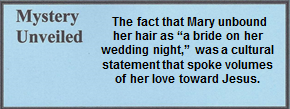
“Your sins are forgiven.” As stated previously, the key idea clearly is about forgiveness. Through Jesus we are forgiven, Greek aphiesthai, from whatever sin separates us from God. The term has a wide variety of meanings, including an undeserved release of obligation, punishment, and other penalties that could be required. It is by His love, grace, and mercy that we are forgiven if we are repentant.[22]
With the statement “your sins are forgiven,” Jesus declared that He was God – an absolute declaration of divinity.[23] Since the Jews believed only God could forgive sins, they were faced with the decision of what to do with Jesus. Clearly, He set Himself as equal with God. Furthermore, He not only forgave others as a man, but also as God. This account is full of interesting irony. The Pharisee invited Jesus into his home to insult Him and prove that He was not a prophet, while the sinful woman honored Jesus and worshiped Him as Lord.
[1]. Blomberg, “The Authenticity and Significance of Jesus’ Table Fellowship with Sinners.” 232-33.
[2]. Bailey, Jesus through Middle Eastern Eyes. 249-51; Compare with Josephus, Antiquities 4.8.23, and the complete section of Mishnah, Ketubbat, 6.6.
[3]. Lang, Know the Words of Jesus. 248; See also 02.01.14 “Pharisees.”
[4]. Geikie, The Life and Works of Christ. 1:488.
[5]. “First Century Synagogue Found.” Israel Today E-Newsletter. January 15, 2013.
[6]. See 14.02.04.A. An illustration of a triclinium table.
[7]. Scientifically, it is known as carbonate of Calcium.
[8]. Dayagi-Mendels, Perfumes and Cosmetics in the Ancient World. 116.
[9]. Farrar, Life of Christ. 137.
[10]. Bailey, Jesus through Middle Eastern Eyes. 246 n16.
[11]. Freeman, The New Manners and Customs of the Bible. 504.
[12]. Pentecost, The Words and Works of Jesus Christ. 203.
[13]. For further study on the various opinions concerning the status and influence of women in the Second Temple Period, see the excellent work by Tal Ilan, Integrating Women into Second Temple History, Peabody, MA: Hendrickson, 1999. Take note of Chapter 3 on the discussions of two first century historians, Josephus and Nicholaus of Damascus, and their comments about women. Nicholaus was the personal historian for Herod the Great.
[14]. Cited by Metzger, ed., The Apocrypha of the Old Testament. 161; Ben Sirach and Tobit belong to a classification of extra-biblical books known as the Apocrypha. These two literary works reflect the opinions of many Jewish people. See 02.02.03 “Apocrypha” for more information. The reader is reminded that quotations from non-biblical sources are not to be understood as being of equal authority with the biblical narratives. See 01.02.04.
[15]. Josephus, Antiquities 4.8.15.
[16]. Mishnah, Zeraim Berakoth 7.2.
[17]. Mishnah, Tohoroth Tohoroth 7.9
[18]. Wilson, “Should Women Wear Head Coverings?” 442-62.
[19]. Mishnah, Ketuboth 2.1; Jeremias, Jerusalem in the Time of Jesus. 359-61. For further study, see Chapter 18 “The Social Position of Women” in Jeremias, Jerusalem in the Time of Jesus; See also Wilson, “Should Women Wear Head Coverings?” 442-62.
[20]. For related divorce issues, see Josephus, Antiquities 4.8.23.
[21]. Danby, ed., Mishnah ix.
[22]. Barclay, A New Testament Wordbook. 53-55.
[23]. Lang, Know the Words of Jesus. 253.
